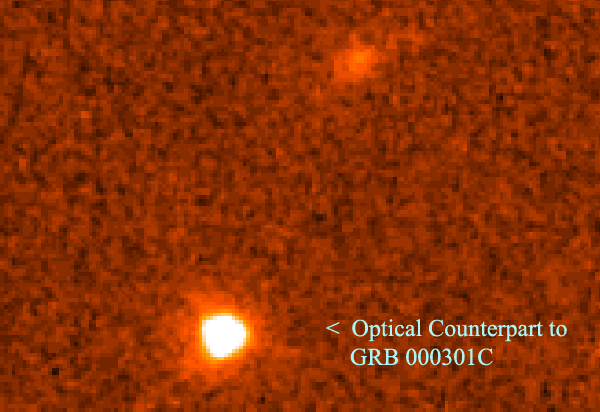A GRB 000301C Symphony

Explanation:
Telescopic instruments in Earth and space are still tracking
a tremendous explosion that occurred across the universe.
A nearly unprecedented symphony of international observations began
abruptly on March 1 when Earth-orbiting
RXTE,
Sun-orbiting
Ulysses,
and asteroid-orbiting
NEAR
all
detected
a 10-second
burst of high-frequency
gamma radiation.
Within 48 hours astronomers using the 2.5-meter
Nordic Optical Telescope
chimed in with the observation of a middle-frequency
optical counterpart
that was soon confirmed with the 3.5-meter
Calar Alto Telescope in Spain.
By the next day the explosion was picked up in low-frequency
radio waves by the by the European
IRAM 30-meter dish in Spain,
and then by the
VLA telescopes in the US.
The Japanese 8-meter
Subaru Telescope interrupted a
maiden engineering test to trumpet in
infrared observations.
Major telescopes across the globe soon began
playing along as GRB 000301C came into view, detailing
unusual behavior.
The
Hubble Space Telescope
captured the
above image and was the first to
obtain an accurate distance to the explosion,
placing it near redshift 2, most of the way across the visible
universe.
The
Keck II Telescope in Hawaii quickly
confirmed and refined the redshift.
Still, no one is sure what
type of explosion
this was.
The symphony is not over - oddly no
host galaxy
appears near the position of this explosion.
Will one appear as the din of the loud
fireball fades?
Authors & editors:
Robert Nemiroff
(MTU) &
Jerry Bonnell
(USRA)
NASA Web Site Statements, Warnings,
and Disclaimers
NASA Official: Jay Norris.
Specific
rights apply.
A service of:
LHEA at
NASA /
GSFC
& Michigan Tech. U.

